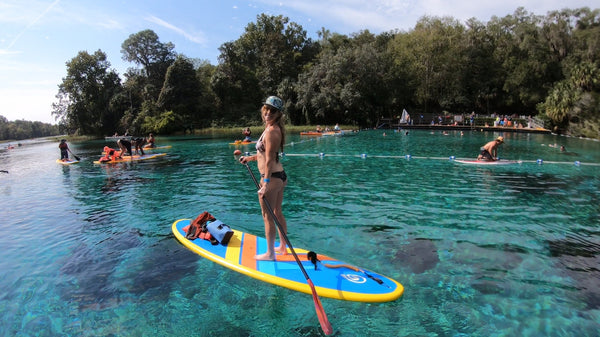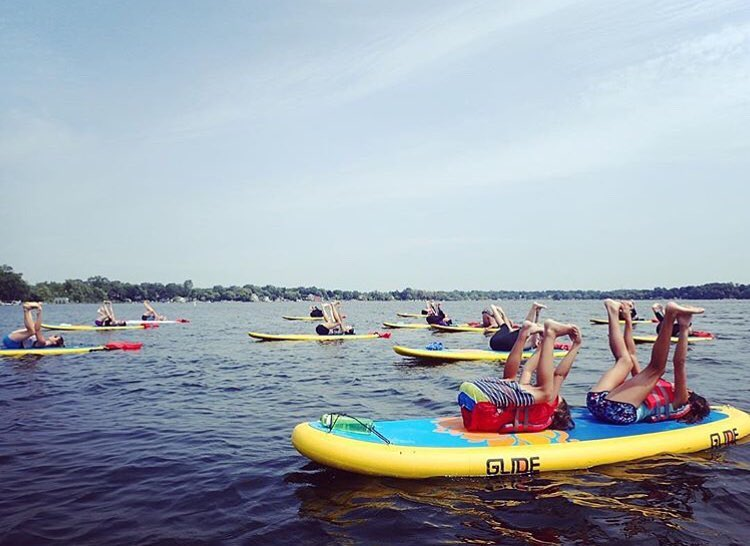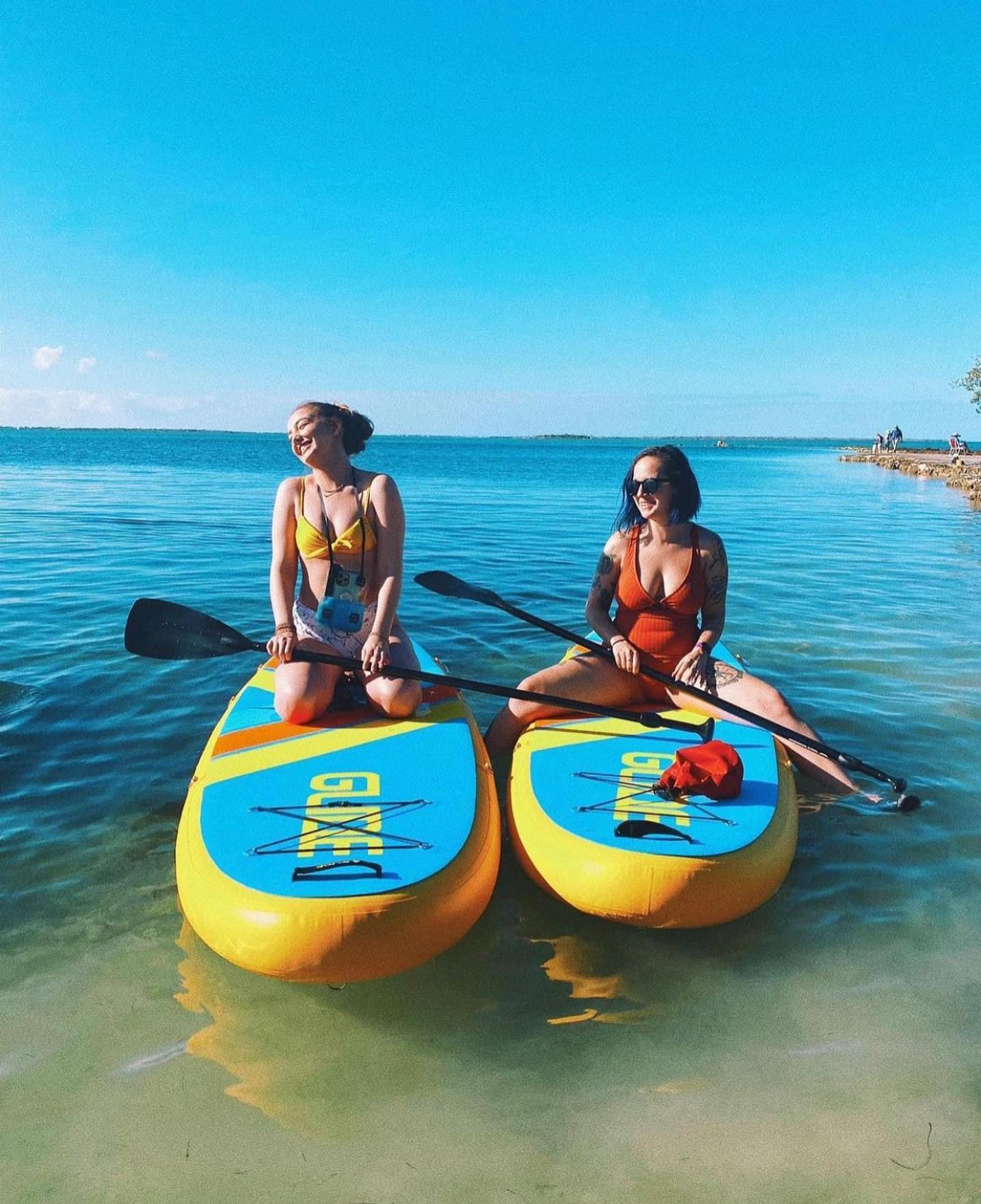
Inflatable vs Hard Paddle Boards: The Ultimate Glide Guide
Our latest article in the inflatable vs hard paddle boards debate. You will want to read this article before you buy.
If you're trying to decide between an inflatable and a hard paddle board, you’re not alone. This is one of the most common questions for first-time buyers—and for good reason. Your choice impacts how often you paddle, where you can go, how you store your board, and how much fun you’ll have on the water.
At Glide, we build both inflatable and hard paddle boards. We’ve shaped boards for surf, fitness, whitewater, racing, yoga, fishing, and everything in between. We don’t just sell them—we paddle them. And we’ve learned exactly what matters when choosing the right board.
In this guide, we’ll break down the difference between inflatable and hard paddle boards from every angle: performance, portability, durability, comfort, price, storage, and more. We’ll also include a chart comparison, bust common myths, and give you real-world use cases to help you make the most informed decision possible.
Which One’s Better?

It depends on your needs. But for most people—especially beginners—an inflatable paddle board is the best place to start. It’s easier to store, transport, and travel with, more durable than you think, and incredibly stable.
If you live near the water and plan to surf or race, a hard board might make sense. But for everyone else? Inflatable wins.
Inflatable vs Hard Paddle Boards: Side-by-Side Comparison
|
Feature
|
Inflatable SUP
|
Hard Paddle Board
|
|---|---|---|
|
Portability
|
Rolls into a backpack; fits in a car or closet
|
Needs roof rack or large storage area
|
|
Storage
|
Easy to store in tight spaces
|
Requires garage or outdoor rack
|
|
Durability
|
Extremely tough PVC; bounces off rocks
|
Can chip, crack, or ding on impact
|
|
Setup Time
|
5–10 min inflation (manual or electric pump)
|
Ready to go immediately
|
|
Performance
|
Stable, responsive; great for all-around use
|
Slight edge in glide, speed, and surf
|
|
Comfort
|
Softer deck; better for falls or yoga
|
Firm surface; can be unforgiving
|
|
Weight
|
Lighter to carry (esp. newer woven inflatables)
|
Heavier and bulkier to move
|
|
Cost
|
More affordable starter packages
|
Often more expensive, especially with gear
|
|
Travel Friendly
|
Airline checkable; adventure-ready
|
Not travel-friendly
|
|
Beginner Friendly
|
YES: forgiving, stable, and confidence-building
|
Some can be, but less forgiving
|

What’s a Hard Paddle Board?
Hard boards (also called epoxy or rigid boards) are built with an EPS foam core wrapped in fiberglass and epoxy resin, or sometimes carbon fiber. They’re the original SUP design and still the go-to for racing and surf.
Pros:
-
Slightly better glide and tracking on flatwater
-
Sharper turns and performance in waves
-
No need to inflate—just grab and go
-
Consistent firmness with no PSI to worry about
-
Can feel more “pro” or premium for some riders
Cons:
-
Heavy and hard to transport solo
-
Susceptible to damage: dings, chips, cracks
-
Requires a lot of storage space
-
Not ideal for travel or flights
-
Hurts more when you fall or bump it

What’s an Inflatable Paddle Board?
Inflatable paddle boards (iSUPs) are made with military-grade PVC and drop-stitch construction that lets them inflate to a high PSI for incredible rigidity. High-quality iSUPs feel solid underfoot and ride surprisingly close to hard boards.
Modern inflatables have become the standard for most new paddlers and for anyone who wants to explore more places without all the bulk and logistics of a hard board.
Pros:
-
Rolls up to fit in a backpack
-
Stores easily in small apartments or closets
-
Durable: bounces off rocks, docks, and rough shores
-
Softer and safer for falls
-
Great for beginners, families, and fitness
-
Travel-friendly and car-trunk friendly
-
Comes as a complete package (board, paddle, pump, leash, bag)
-
Easy to repair if punctured (but that’s rare)
Cons:
-
Takes 5–10 minutes to inflate
-
Must rinse and dry before long-term storage
-
Slightly thicker and less precise than hard boards in waves
-
Needs to be inflated to the correct PSI to perform best
When to Choose an Inflatable SUP
-
You live in a small space or apartment
-
You drive a small car (or no car at all)
-
You want to take your board on vacation or flights
-
You’re a beginner or casual paddler
-
You plan to do yoga, fish, or paddle with your dog/kids
-
You want to avoid dings and damage
-
You value comfort and ease over peak performance
-
You want a more affordable, all-in-one package
When a Hard Board Might Be Right
-
You live on the water and paddle frequently
-
You’re racing, surfing, or chasing top performance
-
You don’t mind using a roof rack or wall storage
-
You want max glide and responsiveness
-
You plan to paddle in surf and want the feel of rigid rails
-
You prioritize grab-and-go simplicity over portability
Paddle Boarding Use Cases (Real-World Examples)
|
Paddler Type
|
Best Board Type
|
Why It Works
|
|---|---|---|
|
Apartment Dweller
|
Inflatable
|
No space for hard board storage
|
|
Beginner or First-Time Paddler
|
Inflatable
|
More stable, safer for falls, easier to learn
|
|
SUP Yogi
|
Inflatable
|
Softer deck, more comfort for poses
|
|
Lake Explorer
|
Inflatable or Hard
|
Both work; inflatable wins for portability
|
|
Surf Enthusiast
|
Hard
|
Better edge control in waves
|
|
Family With Kids or Dogs
|
Inflatable
|
Safer and more forgiving deck
|
|
Frequent Traveler
|
Inflatable
|
Can fly with it, check it in a bag
|
|
SUP Racer or Performance Paddler
|
Hard
|
Faster, more hydrodynamic shape
|
Myths About Inflatable Paddle Boards (Busted)
Myth: Inflatable SUPs are flimsy or toy-like
Truth: High-quality inflatables (like Glide’s) use woven drop-stitch cores and reinforced seams. They’re incredibly stiff and durable.
Truth: High-quality inflatables (like Glide’s) use woven drop-stitch cores and reinforced seams. They’re incredibly stiff and durable.
Myth: You can’t surf or race with an inflatable
Truth: You can! Inflatables may not outperform top-tier carbon race boards, but they’re surprisingly capable in surf and flatwater speed.
Truth: You can! Inflatables may not outperform top-tier carbon race boards, but they’re surprisingly capable in surf and flatwater speed.
Myth: They’re hard to inflate
Truth: With a dual-action or electric pump, most inflatables are ready to go in under 10 minutes. Many paddlers actually prefer the warm-up.
Truth: With a dual-action or electric pump, most inflatables are ready to go in under 10 minutes. Many paddlers actually prefer the warm-up.
Myth: They pop easily
Truth: Inflatable boards are designed to take a beating. Most damage to SUPs happens to hard boards, not inflatables.
Truth: Inflatable boards are designed to take a beating. Most damage to SUPs happens to hard boards, not inflatables.
Myth: You have to deflate after every paddle
Truth: Nope. You can leave your board inflated for weeks if it’s out of the sun and stored properly.
Truth: Nope. You can leave your board inflated for weeks if it’s out of the sun and stored properly.
How Long Do Inflatable Paddle Boards Last?
With proper care, a quality inflatable paddle board can last up to 10 years or more. Glide boards are built to handle serious use. In fact, we design inflatables tough enough for rental fleets, rivers, and whitewater.
To extend the life of your board:
-
Rinse with fresh water after use (especially in salt water)
-
Dry completely before storage
-
Avoid long exposure to direct sunlight
-
Don’t roll too tightly
-
Store in a cool, dry place
Maintenance: Inflatable vs Hard Board
|
Maintenance Area
|
Inflatable SUP
|
Hard SUP
|
|---|---|---|
|
Rinsing After Use
|
Recommended for longevity
|
Also recommended
|
|
Dry Before Storage
|
Must be completely dry
|
Not as critical
|
|
UV Protection
|
Important (UV weakens seams over time)
|
Important (can fade or damage fiberglass)
|
|
Damage Risk
|
Low (bounce, not break)
|
Higher (dings, cracks, leaks)
|
|
Repairability
|
Easy patches for punctures
|
May require fiberglass/epoxy repair
|
Price Comparison
|
Type
|
Entry-Level Price Range
|
High-End Price Range
|
|---|---|---|
|
Inflatable SUP
|
$300–$700 (complete kits)
|
$900–$1,200+ (touring/fishing)
|
|
Hard Paddle Board
|
$700–$1,200+ (board only)
|
$1,500–$2,000+ (carbon race)
|
Still Not Sure? Take the Quiz
We built a quick Paddle Board Finder Quiz to help you decide. Just answer a few questions and we’ll match you with your ideal board.

